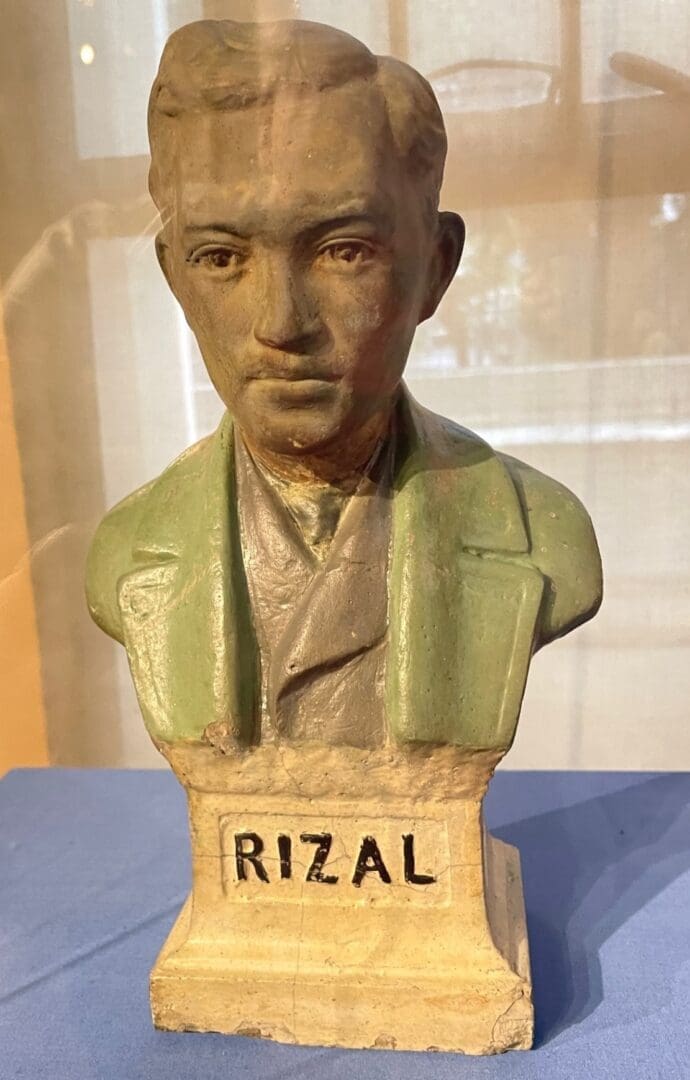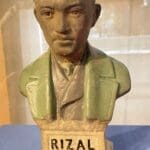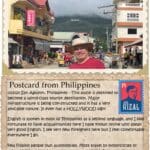Jose Rizal: PH National Hero for Independence

The content below was originally paywalled.
Alaska doesn’t have a National Hero. We have a lot of people with names attached to monuments of various kinds but no hero. Think about it: As a colony of the United States of America, most events that have impacted Alaska were not done for the public interest of Alaskans. Most were for the fatherland or for special interests. Our inflated economy controlled by Seattle does not invite people to live here indefinitely, only to find opportunity and exploit it.
But Alaska has something else to offer:
We are the linchpin between East and West.

[2]Anchorage AK: Air crossroads of the World

What MIGHT an Alaskan have to do to become our
National Hero?
As the National Hero of Philippines, Jose Rizal was a remarkable man. I have now read quite a lot about why is name is everywhere, from the one-peso coin with his likeness to the main road through Manila. Monuments to Rizal are everywhere and an entire section of the Philippine National Museum is dedicated to this National Hero.

[3]Philippines National Museum

Rizal was trained as a doctor who wrote a lot about the contrast between the natural qualities of Filipino people, and trauma of his time, in what some have described as the Colonial Mentality from Spanish Occupation. Today Filipino students must learn about the National Hero, and read his two novels Noli Me Tangere (Latin for Do Not Touch Me) and El Filibusterismo. (Spanish for The Filibuster, or subversive). I have read both books and enjoyed the description of day-to-day life of common Filipino people during the late 1800s, and Rizal’s fervent Nationalism. Rizal’s writings could be construed as anti-Catholic Church because of his criticism of Catholic friars–who took their orders from the Vatican and Madrid–but often exploited the situation for personal gain.
Rizal’s books were written as fiction, but characters were based on real people and events as the Spanish Empire was imploding and the overriding Spanish Friars overplayed their power position.
[4]Jose Rizal, June 19, 1861-December 30, 1896.
It’s alright with this writer that Rizal challenged institutional corruption in the Catholic Church, because I am a member of the Lutheran Church (WELS). By Providence I attended Immanuel Lutheran School in Albuquerque, NM for grades 1-3. I do not know why my mother insisted that I attend a school in downtown–that I had to ride public transportation from a suburb to get to–but my reward has been a firm Christian grounding. As my family also imploded I have attended a variety of churches over the decades and managed to get my Bachelor Degree from Alaska Methodist University. Christian values and faith in Jesus Christ led to finding my latest church-home at Peace Lutheran Church in Eagle River, Alaska, where my late wife Cathy and I became members.
[5]Immanuel Lutheran School, Albuquerque, NM

[6]Peace Lutheran Church, Eagle River, AK

This is relevant because Dr. Rizal became alienated to the Catholic Church for very similar reasons as Martin Luther had. As a priest and high Catholic official Luther realized the utter corruption in that institution and revolted against it during the early 1500s. This led to the Protestant Reformation and organization of all the other religious denominations NOT affiliated with the Catholic Church today.

Martin Luther was the Donald Trump of 1517
Luther was the catalyst who transcribed the Bible into German, so anybody could read it, instead of depending upon what the Catholic representatives said was stated in Latin Scriptures. Luther wrote hymns and encouraged singing in the church service, including perhaps his most famous song A Mighty Fortress is our God.
[7]Martin Luther, November 10, 1483-February 18, 1546
But Philippines is a long way from Germany and Spain kept the island country in its steel grip with the Catholic Church as agent and enforcer over three contraries. Today Philippines is still predominately Catholic and Rizal is revered as a martyr.

Filipino Self-reflection: What characterized a sick Filipino society in Rizal’s time is essentially the same society that it is today, according to an instruction manual for teachers of the required Rizal courses. An initial diagnosis of the present condition of the country reveals that the malady still exists and it needs medical attention to restore this patient-country to wellness. The Noli and Filio bare the same circumstances of that sick society, past and present, that Rizal dealt with and exposed. A corrupt government officialdom enriching themselves with the people’s money or by receiving bribes in order to dole out governmental favors, irregularities in the conduct of elections, police brutality through extra-judicial killings, the poor getting poorer, laws favoring the rich and mighty, justice only for the rich and educated–with education and even religion as businesses. These are the very characteristics of a society that Rizal was duty-bound to criticize or correct, that are still present today.
[8]Engaging Jose Rizal, P-6.
Another objective of the Rizal Law (requiring study of he National Hero in Public Education) that is equally important is the valuing of freedom and nationalism among the Filipino youth. The Filipino youth occupied a soft spot in Rizal’s heart because in them belongs the honor to shape and direct the destiny of the nation. If Rizal, his peers and others before them planted the seed of nationalism, then the succeeding generations of the youth bear the duty to nurture it and bring it to fruition. They are the fair hope of the fatherland as people to unite in order to attain a common political aspiration such as freedom and self-determination.
[9]Ibid, P-7.
Almost 130 years after Rizal was executed by a firing squad the values and aspirations which he espoused for the Philippines are still a foundation of this country today. As an intellectual who loved his country Rizal inspired fellow countrymen–many who were disgusted with what colonialism had done–to set the stage for inevitable change.
The schools under the colonial masters were not meant to provide meaningful education so much as they were designed to reinforce adherence to the Catholic Church. During the last decade of the 18th Century the class of Filipinos who were Spanish born in Philippines began to build a case for bringing their quality of life and standing as citizens to the same level as those residing in Spain. Their Propagandist Movement believed that by informing the masters in Spain–with constant information advocating modernization of living at the levels enjoyed by most Europeans–such goals would be made to trickle down to the people of Philippines.
Spain controlled availability of land, the courts,
the economy, public education, and quality of all
public institutions.
Rizal had publicly sought assimilation of Filipino and Spanish societies, but he and other nationalists came to believe it was not possible, and ultimately called for separation from Spain. Spanish masters had no interest in giving collaborative autonomy to Philippines. As the Spanish Empire crumbled people in the various colonies began to prepare for their independence in the New World Order.
The Filipino people are survivors because of their
Nationalism.
References:
[1]Sen. Ted Stevens November 18, 1923 – August 1, 21
https://www.britannica.com/biography/Ted-Stevens
[2]Anchorage AK: Air crossroads of the World
[3]Philippines National Museum

[4]Jose Rizal, June 19, 1861-December 30, 1896.
https://www.britannica.com/biography/Jose-Rizal
The son of a prosperous landowner, Rizal was educated inManilaand at theUniversity of Madrid. A brilliant medical student, he soon committed himself to the reform of Spanish rule in his homecountry, though he never advocated Philippine independence. Most of his writing was done in Europe, where he resided between 1882 and 1892.
Rizal was in exile for fear of his life because his books were an affront to the Catholic Church. This led led to his execution upon return to his beloved Philippines.
[5]Immanuel Lutheran School, Albuquerque, NM
[6]Peace Lutheran Church, Eagle River, AK
https://www.facebook.com/peacechurchAK/
[7]Martin Luther, November 10, 1483-February 18, 1546
In the fall of 1517 an ostensiblyinnocuousevent quickly madeLuther’sname a household word in Germany. Irritated byJohann Tetzel, aDominicanfriarwho was reported to have preached to the faithful that the purchase of a letter ofindulgenceentailed the forgiveness of sins, Luther drafted a set of propositions for the purpose of conducting an academic debate onindulgencesat the university inWittenberg.
Luther’s concerns led him to post Ninety-five Theses, propositions for debate concerned with the question ofindulgences, written (inLatin) and possibly posted byMartin Lutheron the door of the Schlosskirche (Castle Church),Wittenberg, on October 31, 1517. This event came to be considered the beginning of theProtestantReformation.
[8]Engaging Jose Rizal, Alfonso C. Balbin Jr. et al, Nieme Publishing House Co. LTD, Quezon City, Philippines, P-6.
[9]Ibid, P-7




